-
Countries
-
Data and Analysis
-
Special Focus
-
Crisis Responses
Assessment Report

Contact
DTM Europe, DTMMediterranean@iom.int
Language
English
Location
Romania
Period Covered
Jul 01 2023
Sep 30 2023
Activity
- Survey
This report analysed data from a survey carried out between July and September 2023 (Quarter 3, Q3). The survey sample included 1,601 individuals who were crossing back to Ukraine, including 1,589 Ukrainian nationals and 12 Third-Country Nationals (TCNs). The analysis focuses on Ukrainian nationals.
- Top 3 countries of stay abroad: Romania (53%), Bulgaria (19%), Italy (5%).
- Top 3 oblasts of origin: Odeska (38%), Chernivetska (16%), Kyiv city (9%).
- Transport to Ukraine: car (68%), bus (14%), walking (10%), minibus (8%).
- Top areas of assistance received*: food (27%), sanitary supplies (19%), accommodation (18%), and financial support (17%).
- Top 3 needs upon crossing back*: financial support (26%), personal safety (19%), and food supply (17%).
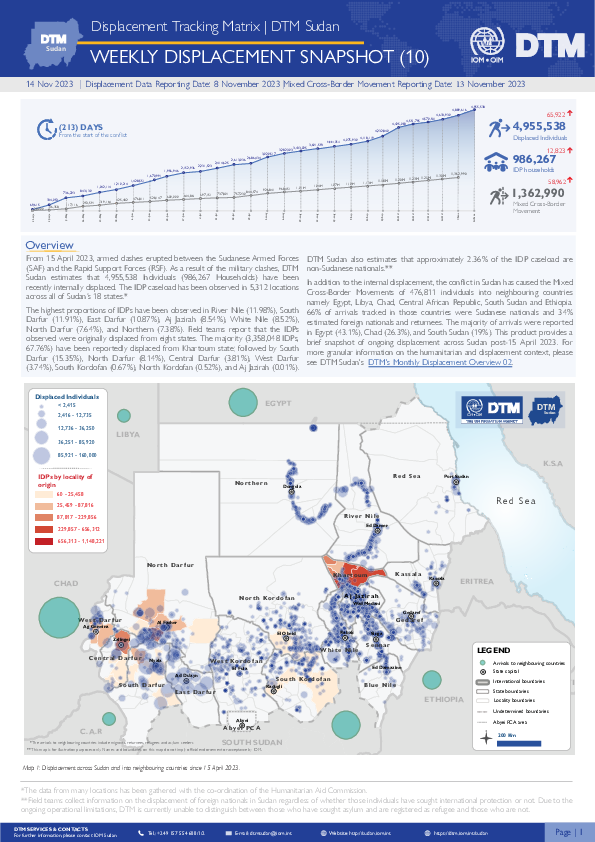
Contact
DTM Sudan; dtmsudan@iom.int
Language
English
Location
Sudan
Snapshot Date
Nov 08 2023
Activity
- Mobility Tracking
- Baseline Assessment
Overview
From 15 April 2023, armed clashes erupted between the Sudanese Armed Forces (SAF) and the Rapid Support Forces (RSF) in multiple cities across Sudan. Clashes initially took place in cities across Northern and Khartoum states, later spreading across the Darfur and Kordofan regions.

Contact
DTM Nigeria, iomnigeriadtm@iom.int
Language
English
Location
Nigeria
Snapshot Date
Nov 01 2023
Activity
- Registration
- Biometric Registration
Registration provides a more in-depth analysis of specific needs by capturing bio data using the DTM-developed Biometric Registration and Verification Application (B.R.a.Ve) system, which accurately registers IDPs. It provides further information on the individuals, households, vulnerability, and displacement-related triggers for programming and response over time.
As part of the commitment to provide verified figures of internally displaced persons (IDPs) in Benue State in line with the government’s plans, IOM DTM, in partnership with UNHCR, Benue State Emergency Management Agency (BSEMA), Nigeria Red Cross Society (NRCS), National Commission for Refugee, Migrants and Internally Displaced Persons (NCFRMI), National Bureau of Statistics (NBS), National Emergency Management Agency (NEMA), Community Links and the Foundation for Justice Development and Peace (FJDP) launched the biometric registration in Benue State on 22 August 2023.
Six LGAs have been mapped as locations with IDPs in Benue State based on DTM Round 11 (March 2023). So far, the biometrically registered IDPs have covered the location of Makurdi LGA (5 camps and two host community sites), Guma LGA (2 camps and two host community sites) and currently ongoing in Logo LGA (1 camp, one host community site and another camp/site). The registration has shown that Guma LGA has the highest number of IDPs, with 23,280 individuals (6,749 HHs), followed by Makurdi with 13,578 individuals (4,020 HHs). The registration is ongoing in Logo LGA, with 10,105 registered individuals (2,433 HHs).
Moreover, 6,153 individuals with vulnerabilities (serious medical illness) have been referred to MSF for further support. All registered IDPs have received a PVC card with a unique number for easy identification. The registration exercise is expected to be completed by December 2023.
The observed challenges include rain disruption, security concerns, access issues, poor networks, and accommodation challenges for the field team in the deep location.
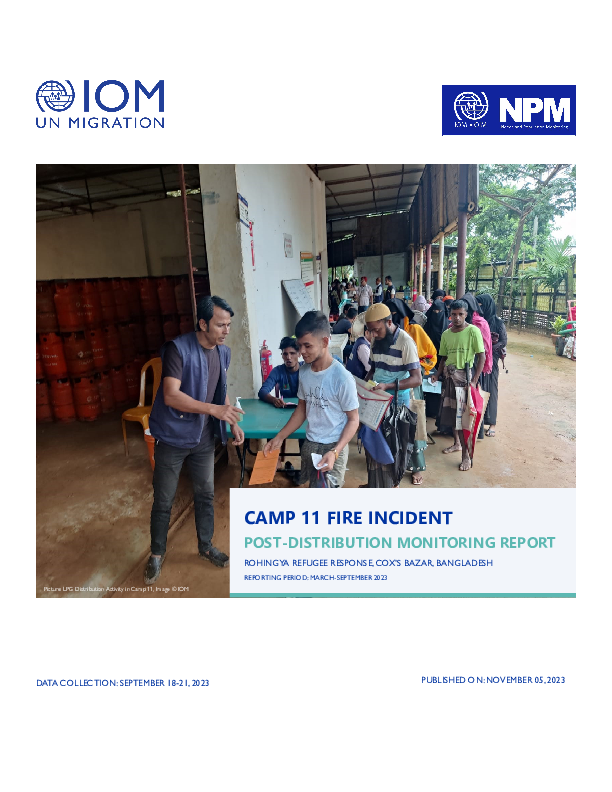
Contact
NPM Bangladesh, npmbangladesh@iom.int
Language
English
Location
Bangladesh
Period Covered
Mar 01 2023
Sep 30 2023
Activity
- Survey
- Community Perception
The world’s largest refugee camp suffered significant damage in certain areas across Camp 11 after a massive fire spread through this camp on March 5, 2023. Three blocks were affected blocks (A, B, and D), with Block D having the most impacted households (1,278). The fire caused to a huge number of shelter damage (2,165 shelters) and the temporary displacement of five thousand people. IOM redirected efforts to support individuals impacted by the fire by deploying staff and resources quickly and remaining present in the camp without interruption.
Moreover, IOM’s Needs and Population Monitoring (NPM) team conducted an Initial Rapid Needs Assessment1 within 24 hours of the incident to provide immediate response and an In-depth Rapid Needs Assessment2 within 48 hours to support effective decision-making processes in meeting the needs of the affected population. In addition, in order to assess and provide an overview of the situation and humanitarian services and gaps, as well as to understand the driver and severity of needs of the affected population from each sector’s perspectives and to know the sufficiency and effectiveness of the assistance provided to the affected households, NPM conducted a household level situational assessment3 in June 2023.
Six months later the fire incident, NPM conducted post-distribution monitoring (PDM) to ascertain the beneficiaries ’ satisfaction and opinions regarding the quality, sufficiency, and effectiveness of the assistance that had been provided to them by various units over the last six months.
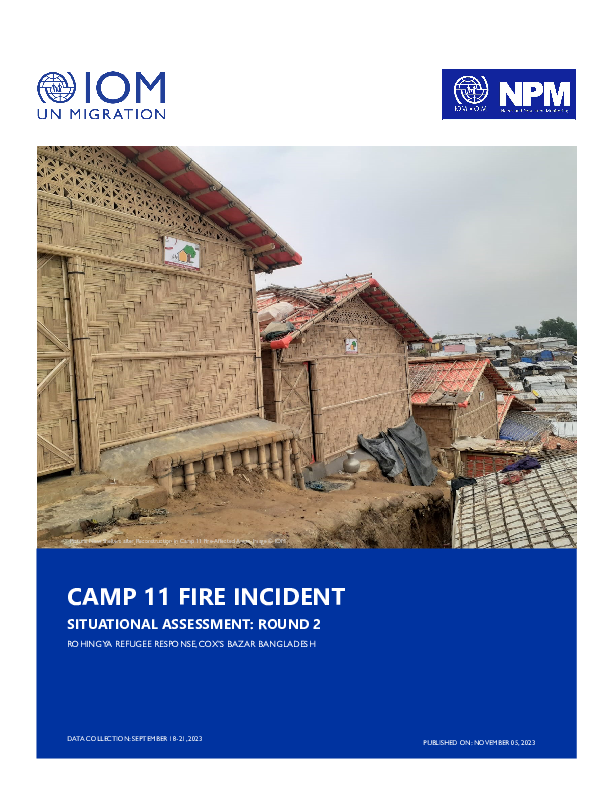
Contact
NPM Bangladesh, npmbangladesh@iom.int
Language
English
Location
Bangladesh
Period Covered
Sep 18 2023
Sep 21 2023
Activity
- Survey
- Community Perception
The massive fire that swept through Camp 11 on March 5, 2023, affecting over 16,000 Rohingya refugees, severely damaged certain areas of the world’s largest refugee camps. Of these, 5,000 Rohingya refugees were temporarily displaced and moved to nearby camps. The fire destroyed 2,165 shelters and affected many refugees who were left with nothing. Three blocks were affected with Block D having the most affected households (1,278). IOM in close coordination with local authorities and the fire brigade immediately dispatched the response teams right away to help the refugees and control the situation. IOM redirected efforts to assist those affected by the fire through rapid deployment of staff, and resources, and uninterrupted presence in the camps.
Moreover, IOM’s Needs and Population Monitoring team conducted Initial Rapid Needs Assessment1 within 24 hours to provide immediate response and In-depth Rapid Needs Assessment2 within 48 hours to support effective decision-making processes in meeting the needs of the affected population.
In addition, three months after the incident in June 2023 NPM conducted the household-level situational assessment3 in order to assess and provide an overview of the current situation and humanitarian services and gaps, as well as to understand the driver and severity of needs of the affected population from each sector’s perspectives and to know the sufficiency and effectiveness of the assistance provided to the affected households. Currently, six months after the fire incident, NPM carried out another situational assessment with similar objectives, including identifying any change to access various services and assistance they have been receiving since the fire incident. This report presents the overall findings of the second-round situation assessment.
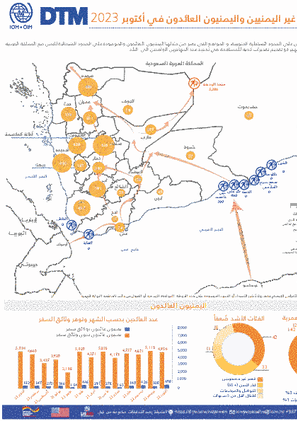
Contact
DTM Yemen, DTMYemen@iom.int
Language
English
Location
Yemen
Period Covered
Oct 01 2023
Oct 31 2023
Activity
- Flow Monitoring
تعمل مصفوفة تتبُع النزوح الخاصة بالمنظمة الدولية للهجرة في اليمن عبر سجل مراقبة التدفق في المواقع الرئيسية التي يصل عبرها المهاجرون على الحدود الساحلية الجنوبية، و المواقع التي يعبر من خلالها اليمنيون العائدون والموجودة على الحدود الشمالية لليمن مع المملكة العربية السعودية. يُراقب الباحثون المتمركزون في نقاط رصد تدفق وصول المهاجرين والمواطنين اليمنيين العائدين من أجل التعرف على الأنماط المختلفة للهجرة وتقديم تقديرات كمية للمساهمة في تحديد عدد المهاجرين الوافدين الى البلد لا يشمل سجل مراقبة التدفق جميع نقاط التدفق في اليمن، ولكنه يمثل مؤشراً حول اتجاهات الهجرة بالنسبة لإجمالي العدد غير المعروف للمهاجرين الوافدين إلى اليمن عبر نقاط التدفق خلال الإطار الزمني المحدد. والجدير بالذكر أن القيود المفروضة على الوصول تَحُد من القدرة على جمع البيانات في بعض نقاط وصول المهاجرين .
في أكتوبر 2023، سجلت مصفوفة تتبع النزوح التابعة للمنظمة الدولية للهجرة في اليمن دخول 1,169 مهاجرًا إلى اليمن، بانخفاض قدره 25 بالمائة مقارنة بالشهر الماضي (1,551). منذ بدء الحملة العسكرية المشتركة قبل ثلاثة أشهر، انخفض عدد المهاجرين الذين يدخلون اليمن عبر ساحل لحج بشكل ملحوظ. وصل الانخفاض إلى أعلى نقطة له في أكتوبر (-100٪) عندما لم يتم الإبلاغ عن دخول مهاجرين إلى اليمن عبر هذا الطريق. وفي أغسطس (2,249) وسبتمبر (548) تم الإبلاغ عن انخفاضات ملحوظة، واستمر هذا الاتجاه حتى أكتوبر حيث لم يتم تسجيل أي مهاجرين قادمين إلى اليمن من جيبوتي. وانتشرت خلال الحملة نقاط عسكرية على الشريط الساحلي لملاحقة قوارب المهربين، واعتقال المهربين الذين ساعدوا في نقل المهاجرين، ومداهمة ممتلكاتهم. ولا تزال الحملة مستمرة في محافظة لحج التي كانت تستقبل أعداداً كبيرة من المهاجرين من جيبوتي قبل أغسطس 2023. وفي المقابل، ارتفع عدد المهاجرين الذين دخلوا شبوة بشكل طفيف بنسبة 17 بالمائة في أكتوبر (1,169) مقارنة بسبتمبر (1,003). ويعتقد أن هذا العدد كان سيرتفع بشكل كبير لولا وصول الإعصار المداري "تيج" إلى اليابسة، والذي تسبب في عدم استقرار الأحوال الجوية البحرية، وتسبب في هطول أمطار غزيرة ورياح قوية تسببت في فيضانات وأضرار في البنية التحتية لمختلف محافظات اليمن بما في ذلك شبوة.
وفقًا لمصفوفة تتبع النزوح، شكلت الحركات الناجمة عن النزاع 78% من جميع الحركات الواردة في أكتوبر 2023. وقد لوحظت هذه الحركات حصريًا في شبوة، مصدرها باري بالصومال (26% أطفال، 19% نساء، و55% رجال).
أدت الأزمة الإنسانية في اليمن وتحديات الوصول إلى المملكة العربية السعودية إلى عودة العديد من المهاجرين إلى القرن الأفريقي. في أكتوبر 2023، سجل فريق مصفوفة تتبع النزوح في جيبوتي 588 مهاجرًا (567 ذكرًا و21 أنثى) انطلقوا في رحلة خطيرة للعودة إلى وطنهم بالقارب من اليمن. بالإضافة إلى ذلك، لاحظت مصفوفة تتبع النزوح زيادة في عدد العائدين اليمنيين بنسبة ثمانية بالمائة في أكتوبر (5,386) مقارنة بشهر سبتمبر (5,007). بين يناير وسبتمبر 2023، سجلت مصفوفة تتبع النزوح إجمالي 93,526 مهاجرًا و45,464 مهاجرًا يمنيًا عائدًا إلى اليمن.
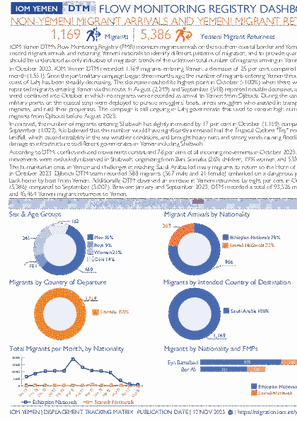
Contact
DTM Yemen, DTMYemen@iom.int
Language
English
Location
Yemen
Period Covered
Oct 01 2023
Oct 31 2023
Activity
- Flow Monitoring
- Mobility Tracking
- Baseline Assessment
IOM Yemen DTM’s Flow Monitoring Registry (FMR) monitors migrant arrivals on the southern coastal border and Yemeni return locations on Yemen's northern border with the Kingdom of Saudi Arabia (KSA). Enumerators placed at Flow Monitoring Points (FMPs) record migrant arrivals and returning Yemeni nationals to identify different patterns of migration, and to provide quantitative estimates to help define the population of irregular migrants entering the country. FMR is not representative of all flows in Yemen and should be understood as only indicative of migration trends of the unknown total number of migrants arriving in Yemen at FMPs during the time frame indicated. Access constraints limit the ability to collect data at some migrant arrival points.
In October 2023, IOM Yemen DTM recorded 1,169 migrants entering Yemen, a decrease of 25 per cent compared to last month (1,551). Since the joint military campaign began three months ago, the number of migrants entering Yemen through the coast of Lahj has been steadily decreasing. The decrease reached its highest point in October (-100%) when there were no reported migrants entering Yemen via this route. In August (2,249) and September (548) reported notable decreases, and this trend continued into October in which no migrants were recorded as arrival to Yemen from Djibouti. During the campaign, military points on the coastal strip were deployed to pursue smugglers’ boats, arrest smugglers who assisted in transporting migrants, and raid their properties. The campaign is still ongoing in Lahj governorate that used to receive high number of migrants from Djibouti before August 2023.
In contrast, the number of migrants entering Shabwah has slightly increased by 17 per cent in October (1,169) compared to September (1,003). It is believed that this number would have significantly increased had the Tropical Cyclone "Tej," not made landfall, which caused instability in the sea weather conditions, and brought heavy rains and strong winds causing flooding and damage to infrastructure to different governorates in Yemen including Shabwah.
According to DTM, conflict-induced movements constituted 78 per cent of all incoming movements in October 2023. These movements were exclusively observed in Shabwah, originating from Bari, Somalia (26% children, 19% women, and 55% men).
The humanitarian crisis in Yemen and challenges in reaching Saudi Arabia led many migrants to return to the Horn of Africa. In October 2023, Djibouti DTM team recorded 588 migrants (567 male and 21 female) embarked on a dangerous journey back home by boat from Yemen. Additionally, DTM observed an increase in Yemeni returnees by eight per cent in October (5,386) compared to September (5,007). Between January and September 2023, DTM recorded a total of 93,526 migrants and 45,464 Yemeni migrant returnees to Yemen.

Contact
DTM Peru, IOMDTMPeru@iom.int
Language
Spanish
Location
Peru
Period Covered
Sep 06 2023
Sep 29 2023
Activity
- Flow Monitoring
En el mes de setiembre, periodo de análisis, el control y vigilancia en las fronteras de Tumbes y Tacna, ubicadas al norte y sur del Perú, se vieron reforzadas por la Policía Nacional del Perú. En la frontera norte (Tumbes), incrementó la presencia policial del lado peruano y ecuatoriano tras el desarticulamiento de organizaciones criminales que operaban en el país, en la modalidad de trata de personas, tráfico de migrantes, tráfico ilícito de sustancias y otros; esto bajo un acuerdo de cooperación con Ecuador. Por el lado sur del país (Tacna), a mitad del mes de setiembre, 180 agentes policiales custodiaron múltiples puntos de entrada para impedir entradas irregulares de refugiados y migrantes a territorio peruano, y hacia fines de setiembre, más de 100 refugiados y migrantes bloquearon durante varias horas las vías que conectan Chile y Perú a modo de protesta por el impedimento de entrada a Perú al no cumplir con la documentación regular.

Contact
DTMUkraine@iom.int
Language
English
Location
Ukraine
Period Covered
Sep 03 2023
Sep 25 2023
Activity
- Survey
Between 3 and 25 September 2023, the International Organization for Migration (IOM) conducted Round 14 of the General Population Survey (GPS), a highly representative assessment of return in Ukraine. This report gathers information on population figures, return flows and mobility intentions, demographic profiles, areas of return and places of last displacement, household composition and vulnerabilities, and needs of returnee populations
Round 14 continues continues to focus on durable solution pathways and sustainable return along criteria proposed by the Inter-Agency Standing Committee Framework on Durable Solutions for IDPs (IASC). This report also includes new sections on winterisation and participation in public affairs. The General Population Survey was constructed through interviews with 20,000 respondents using the computer-assisted telephone interview (CATI) method, and a random digit dial (RDD) approach.

Contact
DTM DRC, iomdrcdtm@iom.int
Language
French
Location
Democratic Republic of the Congo
Period Covered
Aug 03 2023
Sep 12 2023
Activity
- Mobility Tracking
- Baseline Assessment
Compte tenu de la nécessité de disposer d'informations précises et agréées par les autorités, l'OIM, par le biais de la matrice de suivi des déplacements (DTM), a mené des évaluations de suivi de la mobilité (Mobility Tracking - MT en anglais) depuis 2018. Ces exercices sont mis en œuvre en RDC dans le but de fournir des estimations sur la présence, le nombre de groupes de population affectés (PDI, personnes retournées), les raisons du déplacement, la durée du déplacement et les besoins spécifiques dans des lieux définis. Les données pour l'exercice MT sont collectées sur une base semestrielle par des équipes d'enquêteurs formés, par le biais d'entretiens avec des informateurs clés et d'observations directes au niveau des villages. Au cours de ce processus, l'OIM s'assure de la participation des représentants du gouvernement pendant la collecte des données afin de promouvoir et de renforcer les capacités dans l'éventualité d'un transfert. Les données de l'OIM sont ensuite présentées et validées par la Commission de mouvement de population (CMP) de la province.
Les statistiques synthétiques présentées dans ce rapport sont obtenues à partir du cycle de MT le plus récent pour chaque province, qui s'est déroulé entre août et septembre 2023, afin de produire une vue d'ensemble de la situation du déplacement dans la région de l'est de la RDC. Les chiffres concernant les individus déplacés en raison de la crise du M23 sont extraits de la dernière analyse de la crise du M23.
Dans les quatre provinces de l'Est de la RDC, comprenant l'Ituri, le Nord-Kivu, le Sud-Kivu et le Tanganyika, DTM a identifié 5 637 536 personnes déplacées et 4 324 523 personnes retournées, présentes dans 76 pour cent des villages évalués. DTM estime que la plus grande proportion (41%) de personnes déplacées (2 300 163 individus) est installée au Nord-Kivu, suivie par 29 pour cent (1 630 535) en Ituri, 24 pour cent (1 356 376) au Sud-Kivu et 6 pour cent (350 462) au Tanganyika. Les raisons de déplacement les plus fréquemment rapportées par les populations déplacées résidant dans des familles d'accueil sont les attaques de groupes armés (84%), les conflits intercommunautaires (12%) et les catastrophes naturelles (3%). Il est estimé que 908 920 personnes ont été déplacées par la crise du M23 au moment de la dernière analyse de crise de la DTM.
Pagination
- Previous page
- Page 65
- Next page
